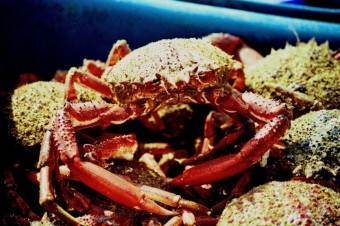Spider crabs – the wildebeest of our waters
 Jack spider crab © S Davis
Jack spider crab © S Davis
Whilst many of us enjoy the odd crab sandwich (or maybe more), far fewer people have sampled the delights of spider crab, despite its delicious sweet flesh and great abundance around our coasts. Perhaps because of this perceived lack of commercial interest, there has been very little targeted research into spider crabs within the UK. By contrast, a great deal of effort has been put into researching these animals in Spain where the major European fisheries are, and also in France, the Channel Islands and Ireland.
There are numerous spider crab species found across the world from Chile to the Lebanon, with the heavy weight title going to a species found in Japan whose leg span can reach over 4 ft! In the waters of Cornwall and in the Helford, there will be both the commercially targeted spiny spider crab which can range in size from 50mm to 200mm along the length of its body, as well as the ‘true’ spider crabs which are delicate little creatures often only 10mm long.
Male spiny spider crabs have a triangular, flattened body with large claws, whilst the females are rounder and have a curved flap underneath their body in which they store their eggs. Generally they have one brood of eggs per year although up to four broods have been reported. Usually these berried (egg bearing) females are not landed as their eggs clog up the tank filters in the lorries in which they are transported to mainland Europe.
Unlike many other crabs, spider crabs do not moult every year. Once they reach their ‘teenage’ phase in their second year, the females have a terminal or final moult, after which they do not grow any further. The males have one additional moult during which they grow their distinctively larger claws which are essential for defence and for successful mating. In a few cases, mutations occur resulting in crabs which have half male and half female characteristics, locally called ‘halfies’ in Cornwall and ‘strangers’ or a more non-pc term further up the south coast! In the population, there will be a range of different sized crabs which may all be of a similar age and they can live for up to 8 years. One interesting piece of recent research has used the rate at which their claws erode as they walk about the seabed, as a way of estimating their age. Younger crabs have pointed black claws whilst the older crabs are walking about on worn out stumps!
They have a complex lifecycle during which they undertake mass migrations annually from our coastal waters to deeper offshore and back again, like the wildebeest of our waters. The juveniles live in shallow rocky areas where they feed on a variety of animal and seaweed species. In order to hide from predators, they decorate their shells with seaweed and sponges and some species are known as ‘decorator’ crabs. The local name for these juveniles is ‘commandoes’, after soldiers’ habit of wearing camouflage on their helmets. Some adults also carry often large numbers of a parasitic sea anemone on their legs.
Once they need to moult, spider crabs will seek shelter and have been recorded in eelgrass beds, ripping up the eelgrass fronds. Newly moulted crabs are bright reddy orange in colour with very sharp spines. In Cornish waters, females will migrate into shallow sandy areas to mate in April and May and they are often found on the seabed in huge mating aggregations of hundreds of animals. It is at this time of the year that they are caught in pots and nets all around Cornwall but especially on the north coast. In the winter, they migrate offshore again and in Falmouth Bay, a number of local vessels from Helford and Cadgwith catch the larger male crabs which command a good price and are a welcome boost to winter earnings.
Once regarded as an unmarketable nuisance by inshore fishermen, common or spiny spider crabs now make up over 30% of crustacean shellfish landings into Cornwall. The overwhelming majority of these crabs are exported alive in vivier lorries to France and Spain as sadly, there is very little domestic demand for them at present. Both male and female crabs are eaten but the males tend to be larger, with more claw meat and therefore more marketable. Often, merchants will not accept the smallest females and this has led to an approach to Cornwall Sea Fisheries Committee to undertake some research into spider crab stocks during 2008, with the aim of investigating the merits of raising the minimum legal size from 120mm to 130mm, the same size as the males (or jacks).
Sam Davis, Fisheries Officer, CSFC
Extract from HVMCA newsletter No.36 Spring 2008







